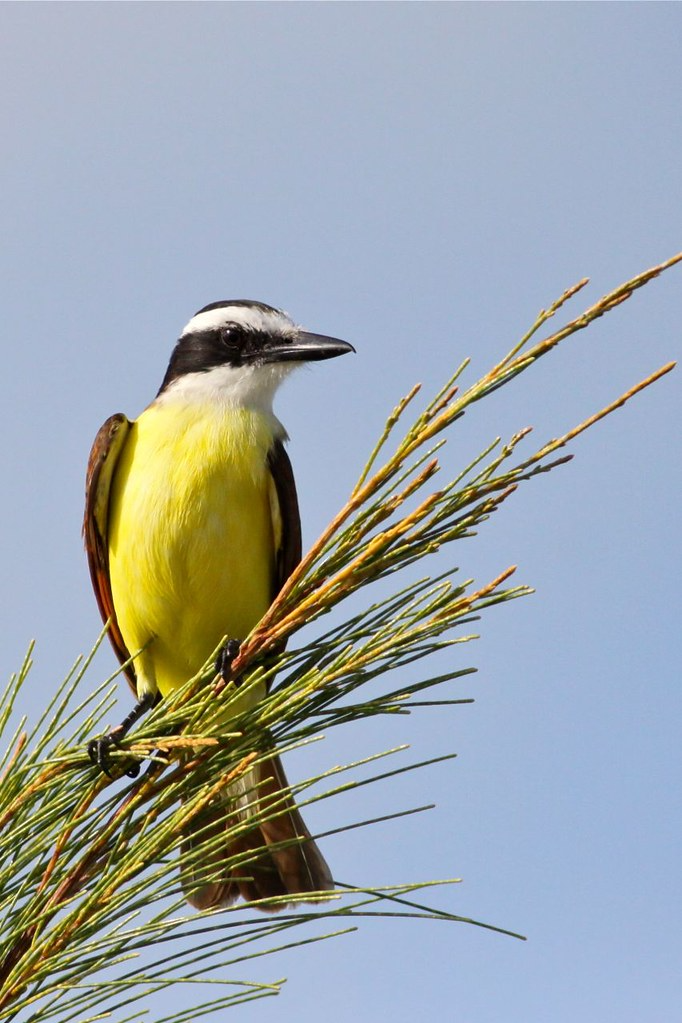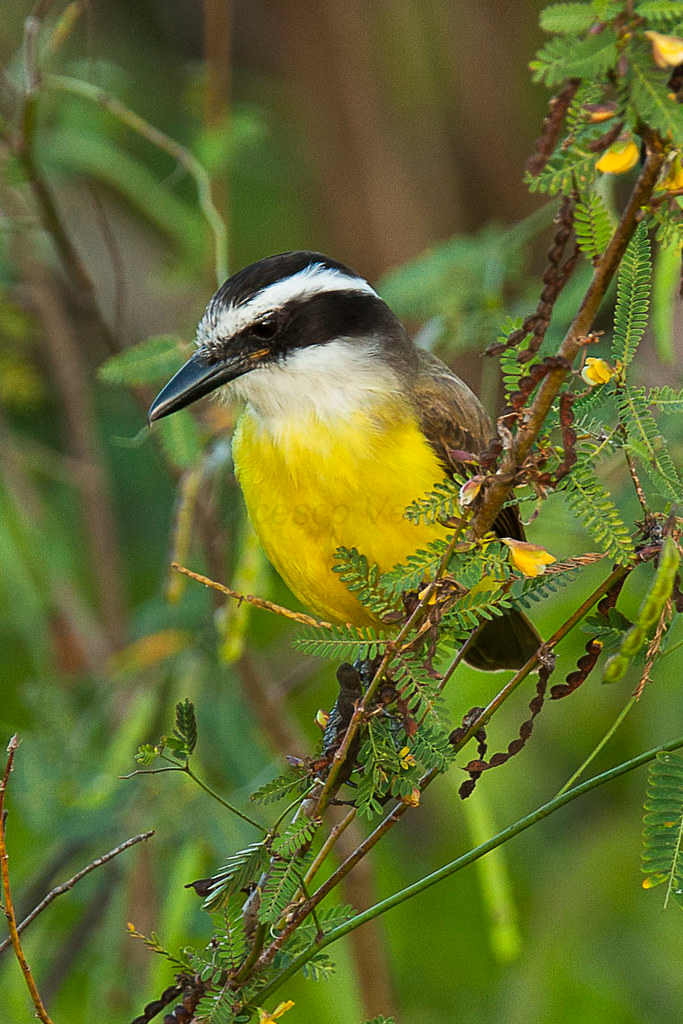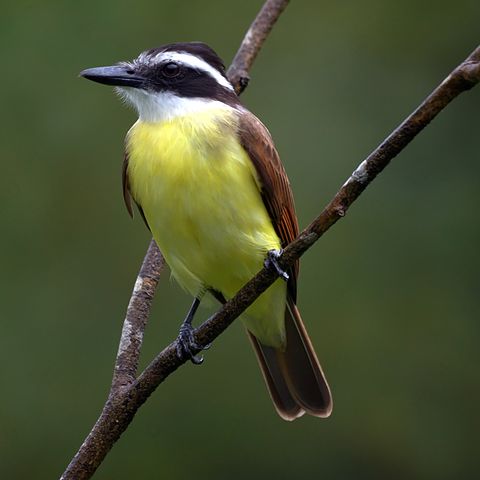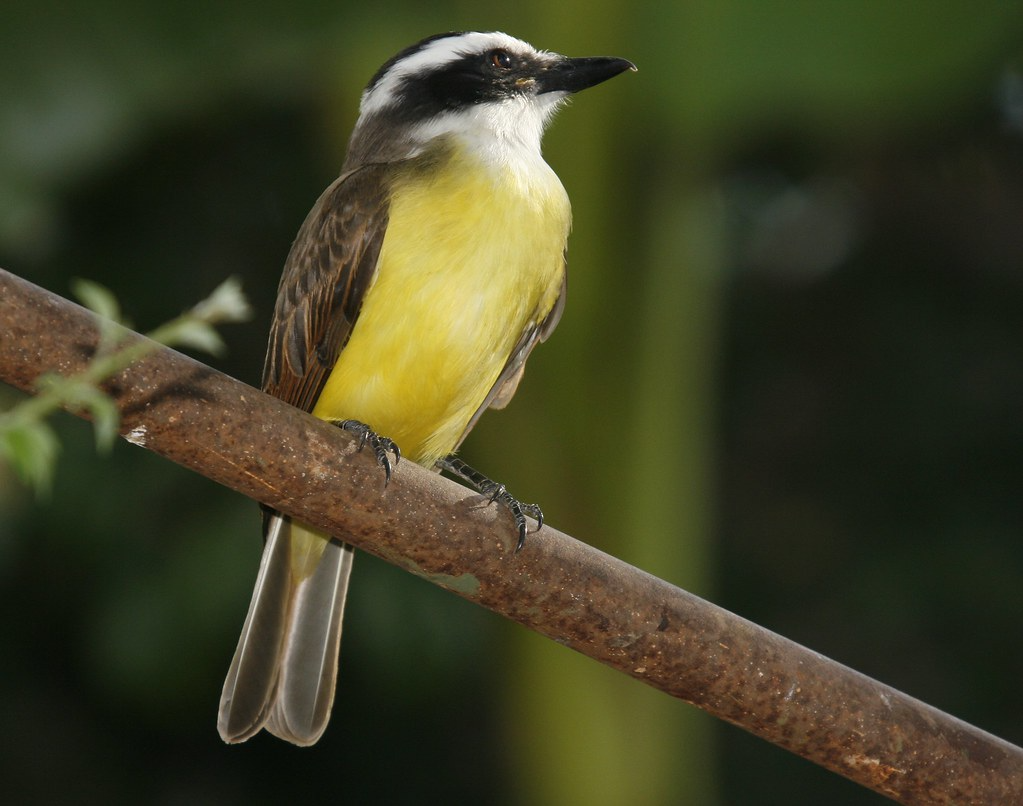A boisterous, bold flycatcher that looks vividly bright with a contrasting yellow belly and black-masked head.
Meet the great kiskadee
 Photo courtesy of dfaulder / CC BY 2.0
Photo courtesy of dfaulder / CC BY 2.0
The great kiskadee (Pitangus sulphuratus), called bem-te-vi in Brazil, is a passerine bird in the tyrant flycatcher family Tyrannidae. Large adult kiskadees are 22 cm long and weigh 63 g. The head is black with a strong white eye stripe and a hidden yellow stripe on the crown. The upperparts are brown, and the wings and tail are brown with usually strong reddish stripes. The black bill is short and thick.
 Photo courtesy of ~Shanth / CC BY-SA 2.0
Photo courtesy of ~Shanth / CC BY-SA 2.0
The similar boat-billed flycatcher has a huge black bill, an olive-brown back, and very little reddish on the tail and wings.
The females look very similar to the males.
 Photo courtesy of berniedup / CC BY-SA 2.0
Photo courtesy of berniedup / CC BY-SA 2.0
It is found primarily in Belize and the lower Rio Grande Valley in southern Texas and northern Mexico. It occurs throughout Brazil and Venezuela (especially the central and south-southeast regions) to southern Argentina and Uruguay, Paraguay and central Argentina, the coast of Guyana and in Trinidad. It was introduced to Bermuda in 1957 and to Tobago in approximately 1970.
 Photo courtesy of fveronesi1 / CC BY-SA 2.0
Photo courtesy of fveronesi1 / CC BY-SA 2.0
The greater kiskadee likes open woodlands with tall trees, including crops and around human habitations.
 Photo courtesy of Sloalan / Public Domain
Photo courtesy of Sloalan / Public Domain
A nearly omnivorous bird, it hunts like a shrike or flycatcher, waiting on an open perch high in a tree to emerge to catch insects in flight, or swooping down on rodents or other small prey. They also take some fruit and occasionally dive for fish in shallow water (making them one of the few fish-eating passerines). This opportunistic feeding behavior makes them one of the most common birds in urban areas of Latin America.
 Photo courtesy of Mike and Chris – Uploaded by berichard / CC BY-SA 2.0
Photo courtesy of Mike and Chris – Uploaded by berichard / CC BY-SA 2.0
The nest, built by both sexes in a tree or telephone pole, is a ball of sticks with a side entrance. The typical clutch is 3 or 4 cream-colored eggs slightly spotted with reddish brown. The female incubates them for about 15 days. The young fledge after 16 days. The young are fed by both sexes, sometimes this species is parasitized by Shiny Cowbirds. Kiskadees are monogamous. A male will mate with only one female. The mating season begins at the end of March. The female great kiskadee lays two to five creamy white, brown-speckled eggs in a domed nest made of sticks, grass, moss and bark. The nest has a single entrance hole and is lined with soft materials such as wool and feathers. The nest is usually built in a thorn tree or bush. Both parents defend the nesting territory and care for the young.
 Photo courtesy of Wagner Machado Carlos Lemes / CC BY 2.0
Photo courtesy of Wagner Machado Carlos Lemes / CC BY 2.0
This species has a wide distribution, with an estimated global extent of presence of 16,000,000 km². It has a large world population, estimated at 5,000,000? 50,000,000 individuals (Rich et al. 2003). Global population trends have not been quantified, but the species is not believed to be approaching the IUCN Red List population decline criterion thresholds.
 Photo (cropped) Courtesy of Becky Matsubara / CC BY 2.0
Photo (cropped) Courtesy of Becky Matsubara / CC BY 2.0
Watch and listen to this bird below:





